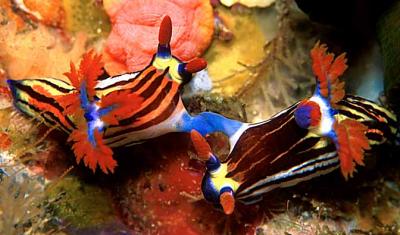

Nembrotha aurea
Pola, Cervera & Gosliner, 2008
Order: NUDIBRANCHIA
Suborder: DORIDINA
Superfamily: ANADORIDOIDEA
Family: Polyceridae
Subfamily: Nembrothinae
DISTRIBUTION
Tropical Indo-West Pacific
PHOTO
Upper: near Padar Island, Indonesia (part of Komodo National Park). Photo: Ken Knezick. Lower: Sodwana Bay, 30 metres, South Africa, Indian, 13 March 2006, Coral reef. Length: 30 mm. Photographer: Colin Ogden.
Externally the animals are characterised by the presence of longitudinal brown lines of irregular width and large diffuse patches of yellow and orange. Usually, the lines are arranged as follows: one broad mid-dorsal line between the rhinophores and the gills and two shorter ones of similar width on each side of the middle line; There is also a similar line outside these, at the edge of the mantle, which runs outside the gills and then behind them to converge with the corresponding line on the otherside to form a single line which runs back to the posterior end of the foot. Anteriorly this line runs around the rhinophores to join its counterpart in the anterior midline. There are also similar lines running down each side of the body. In some animals the brown bands can be very wide and can even coalesce to form an almost solid brown dorsal patch., while in others the lines can be thin and more numerous making the animal look more like N. lineolata.
The ground colour of the body is white or cream white. There is a large dorsal orange to orange-brown background patch yellow patch between the gills and the rhinophores and another large dorsal orange patch behind the gills. Often the rest of the dorsal background can be bright yellow, or parts of it have yellow patches. There can also be distinctive blue or purple markings, but in some animals these are only very faint. They can be present on the oral tentacles, the margin of the foot, the base of the rhinophore sheaths, and the base of the gills. The rhinophores are red. The rhinophore sheaths range from white to blue, and in some specimens are edges with dark brown. The gills are red and their stalks white or blue.
Apart from the orange patches it is quite difficult to differentiate this species from N. purpureolineata (which is now considered the senior synonym of N. rutilans). Both show a very similar range of colour variation, and both have a very similar internal anatomy.
- O'Donoghue, C. H. (1924) Report on Opisthobranchiata from the Abrolhos Islands, Western Australia, with description of a new parasitic copepod. Journal of the Linnean Society, London 35: 521-579, Pls.27-30.
- Pola, M., Cervera, J.L. and Gosliner, T.M. 2008. Revision of the Indo-Pacific genus Nembrotha (Nudibranchia: Dorididae: Polyceridae), with description of two new species. Scientia Marina 72(1): 145-183.
Rudman, W.B., 2008 (March 4) Nembrotha aurea Pola, Cervera & Gosliner, 2008. [In] Sea Slug Forum. Australian Museum, Sydney. Available from http://www.seaslugforum.net/find/nembaure
Related messages
Nembrotha aurea being eaten by Robostra luteolineata [2]
April 15, 2008
From: Colin Ogden
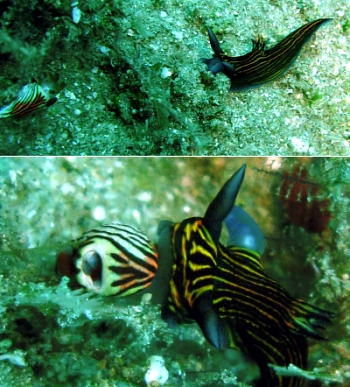
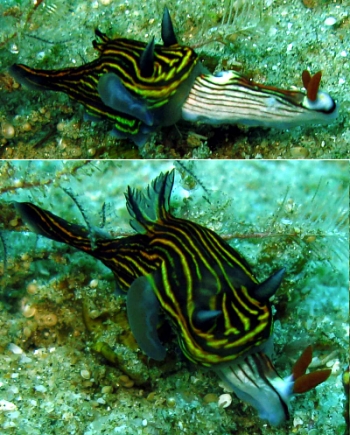
Concerning message #21526:
To accompany his previous message, here are all Colin Ogden's photos of Nembrotha aurea being eaten by Roboastra luteolineata arranged in sequence.
scubaco@iafrica.com
Ogden C. M., 2008 (Apr 15) Nembrotha aurea being eaten by Robostra luteolineata [2]. [Message in] Sea Slug Forum. Australian Museum, Sydney. Available from http://www.seaslugforum.net/find/21527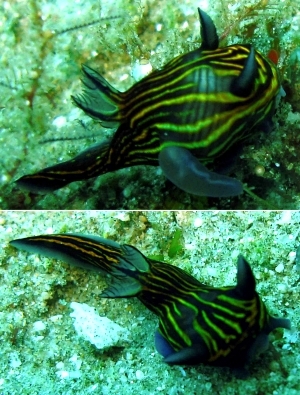
Locality: Sodwana Bay, 22 metres, South Africa, Indian, 13 April 2008, reef. Length: 35 mm & 20 mm. Photographer: Colin Ogden.
Nembrotha aurea being eaten by Robostra luteolineata [1]
April 15, 2008
From: Colin Ogden
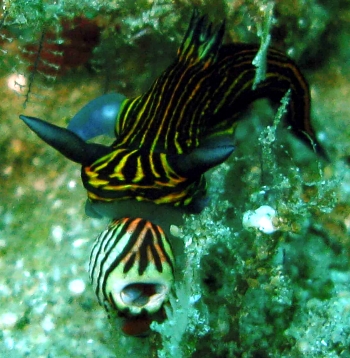
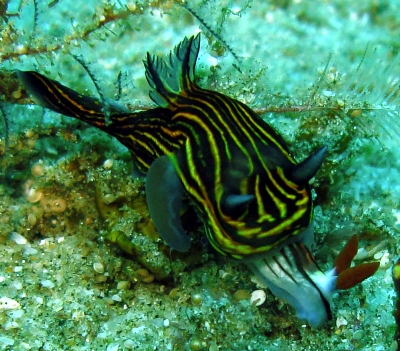
Concerning message #21419:
Hi Bill,
I had a fascinating experience on a dive today. I came across these two nudibranchs about 10 cm apart. The predator (which I think is a Roboastra luteolineata or maybe a Tambja zulu) was moving very fast, and on the photo you can see it is actually preparing its mouth for a meal. The Nembrotha aurea was totally unaware of the threat. As the Roboastra approached within 2 cm the Nembrotha sensed his presence and tried to swim away without success. The Roboastra then caught the Nembrotha who immediately retracted his gills. Also the Robastra is obviously very aroused as it has its sexual organs fully extended. The Roboastra then swallowed the Nembrotha and the entire process took just over 3 minutes. The final photos are of the Roboastra moving off very sluggish and swollen after his meal. I found this quite an emotional experience, as the N. aurea has just been described, and followed my recent message when I found two mating - "Creation and destruction in 2 days"
Locality: Sodwana Bay, 22 metres, South Africa, Indian, 13 April 2008, reef. Length: 35mm & 20mm. Photographer: Colin Ogden.
[see message #21527 for full series of photos]
Regards
Colin
scubaco@iafrica.com
Ogden C. M., 2008 (Apr 15) Nembrotha aurea being eaten by Robostra luteolineata [1]. [Message in] Sea Slug Forum. Australian Museum, Sydney. Available from http://www.seaslugforum.net/find/21526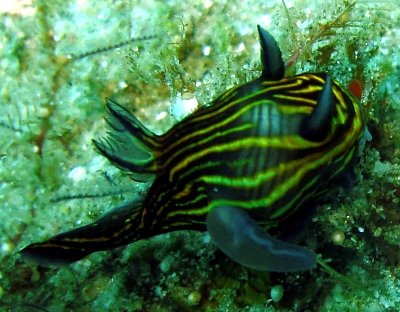
Dear Colin,
Thanks for this fascinating series of photos. Although all nudibranchs are carnivores, it's interesting how we think of hunters which eat large moving prey, such as species of Roboastra and Gymnodoris, in a different way to the majority of nudibranchs that feed on 'plant-like' animals such as hydroids, bryozoans and sponges. It always seems more 'primal'.
The 'hunter' is identified here as R. lutolineata [see #4639] even though South African examples lack the green patches on the head which are found in specimens from the western Pacific. It ceratinly has similalrities in colour to Tambja zulu, but apart from anatomical differences, species of Tambja feed on bryozoans
Best wishes,
Bill Rudman
Re: Nembrotha rutilans, N. aurea & N. purpureolineata
April 15, 2008
From: Colin Ogden
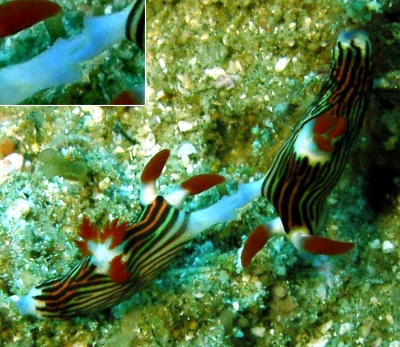
Concerning message #21419:
Hi Bill,
Today I found these Nembrotha aurea mating.
I hope that this can help in sorting out part of the "mist" surrounding these creatures.
Locality: Sodwana Bay, 30 metres, South Africa, Indian, 10 April 2008, reef. Length: 20mm. Photographer: Colin Ogden.
Regards
Colin
scubaco@iafrica.com
Ogden C. M., 2008 (Apr 15) Re: Nembrotha rutilans, N. aurea & N. purpureolineata. [Message in] Sea Slug Forum. Australian Museum, Sydney. Available from http://www.seaslugforum.net/find/21517Dear Colin,
I am sure it will all become clear some time but not quite yet I am afraid. I had hoped that photos of mating animals might show some anatomical features not easily visible in preserved specimens but so far I can see nothing significantly different in the penis structure. Thanks for your contributions. I guess one of the messages I am trying to get across is that we don't know everything - and just because a name, or names, are published in a book, it is no guarantee that we have the correct answer.
Best wishes,
Bill Rudman
Nembrotha rutilans, N. aurea & N. purpureolineata
March 4, 2008
From: Bill Rudman
This may be the only message;I post today as it has involved a lot of moving of messages on the Forum to meet some changes in nembrothid nomenclature.
In Pola, Cervera & Gosliner's new paper on Nembrotha spp they have addressed the confusion surrounding the identity of animals I have previously identified on the Forum as Nembrotha rutilans and Nembrotha purpureolineata. They consider N. rutilans to be a junior synonym of N. purpureolineata, which is a decision I agree with. N. rutilans was named by Pruvot-Fol (1931) on the basis of a colour painting published in 1893, from Queensland, eastern Australia [message #21418], and N. purpureolineata was based on a preserved animal from Western Australia for which we have minimal information on the colour pattern. I think we can be fairly confident that both names are based on the same species. The brown colour pattern ranges from animals with many brown longitudinal lines to others in which the lines are merged into a solid brown 'saddle'.
Previously I have followed Gosliner (1971 - Nudibranchs of Southern Africa) in identifying the relatively common brown-lined Nembrotha from the Indian Ocean as N. purpureolineata. However Pola et al (2008) recognise this as a distinct species which they have named Nembrotha aurea. It seems that the main colour difference between the two species is that N. aurea has two dorsal orange patches, one in front of the gills and one behind. It also appears to have more consistent yellow markings as well. However the main part of the colour pattern of both species is the dark brown which in both species can range from multiple longitudinal brown lines right through to a solid patch [see messages #15763 for variation in N. purpureolineata; #3551 for N. aurea]. I have tried to find some anatomical differences without success. The only difference mentioned by the authors is that the rhachidian tooth in N. purpureolineata is broader than in N. aurea, but I wonder if that is because the animals of N. aurea studied were much smaller? Certainly the shape of the rachidian teeth in both species is remarkably similar, with even the same individual differences in denticulation showing up in both species - compare their Fig 10F with 22B, and 10D with 22C].
I am happy to go along with the separation, and are grateful for the author's work in providing us with so much new information on the anatomy of these animals, but I suspect we are looking at a 'work in progress'. For example what is the relationship between these two species and N. lineolata? Is the animal in message #19337 really N. purpureolineata or is it perhaps N. lineolata? And are the animals in messages #4740, #19904, forms of N. lineolata or a link showing how the brown 'saddle' is formed in N. purpureolineata?
When Terry Gosliner sent a copy of this paper to me he finished the accompanying message with the word 'enjoy'. I can certainly say I have enjoyed reading and thinking about their conclusions. It will certainly make the job of anyone in future studying these animals a lot easier.
-
Pola, M., Cervera, J.L. and Gosliner, T.M. 2008. Revision of the Indo-Pacific genus Nembrotha (Nudibranchia: Dorididae: Polyceridae), with description of two new species. Scientia Marina 72(1): 145-183.
Best wishes,
Bill Rudman
Nembrotha purpureolineata - juvenile
July 13, 2007
From: Wyatt Ang
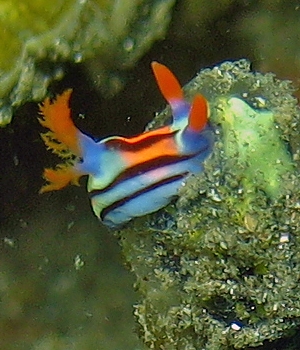
[Note added 4 March 2008: This is the new species Nembrotha aurea - see message #21419]
Season Greetings Bill!
I found this tiny slug which I believed to be a nembrothid but can't find exact reference to the animal i photographed. This specimen was recorded in Lembeh Straits at a site called Aer Perang at a depth of about 11 m amongst coral rubble, rubbish and volcanic sand. The closest i came across was Lindsay's Bluish animal [message #2781] which you suspected to be the juvenile of N. kubaryana. Though my featured animal may be a tiny juvenile, i was skeptical about it being closely related to N. kubaryana. It is somewhat diferent from Lindsay's animal by its wider and sparse longitudinal lines and there's orange colouration dorsally just in between the gills and rhinophores against its baby blue gradient. Any help on Identifical would be appreciated. Thanks in advance!
Locality: Lembeh Straits, 11 m, North Sulawesi, Indonesia, Celebes Sea, 13 November 2006, Coral rubble, Silty, black volcanic sand. Length: 10 mm. Photographer: Wyatt.
Cheers
Wyatt
wyattang@gmail.com
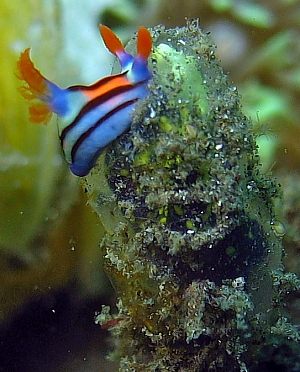
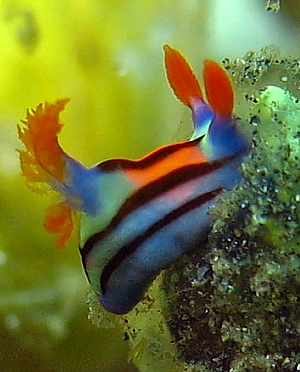
Dear Wyatt,
This is a juvenile Nembrotha purpureolineata. I am not sure why it is apparently burrowing into the object it is sitting on. Perhaps it is an ascidian, which is the food of species of Nembrotha.
Best wishes,
Bill Rudman
Nembrotha purpureolinata - feeding?
March 29, 2006
From: Colin Ogden
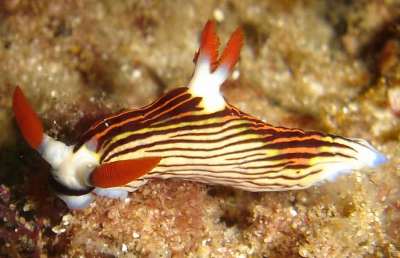
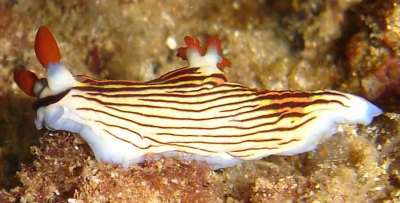
[Note added 4 March 2008: This is the new species Nembrotha aurea - see message #21419]
Hi Bill,
I know we are looking for photos of various nudis feeding, but I don't know if this is one that you need info on, but looking on the forum maybe this might help. It appears to me that it is feeding, but I am not sure what it is eating.
Locality: Sodwana Bay, 30 metres, South Africa, Indian, 13 March 2006, Coral reef. Length: 30mm. Photographer: Colin Ogden.
Regards
Colin
scubaco@iafrica.com
Ogden C. M., 2006 (Mar 29) Nembrotha purpureolinata - feeding?. [Message in] Sea Slug Forum. Australian Museum, Sydney. Available from http://www.seaslugforum.net/find/16112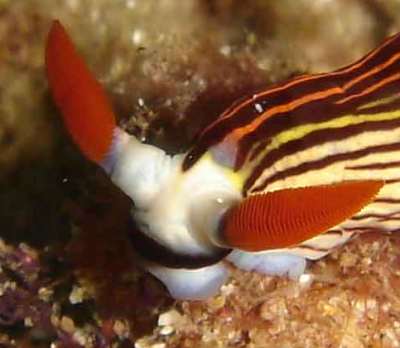
Dear Colin,
It certainly worth sending doubtful photos in - we sometimes get lucky. Although one of the photos seems to suggest it is taking an interest in something I can't see any sign of likely prey. I would suspect that like Nembrotha lineolata [see Brian Francisco's recent message #16176] it would eat a solitary ascidian. Sometimes they are well covered in algae so all you see is their siphons, so it is possible that your Nembrotha could have been feeding on a hidden ascidian. But if that were the case you would have seen the oral tube when you moved the head. I think it must have just been 'sniffing' around.
Best wishes,
Bill Rudman
Nembrotha purpureolineata mating
May 4, 2005
From: Roberto Sozzani
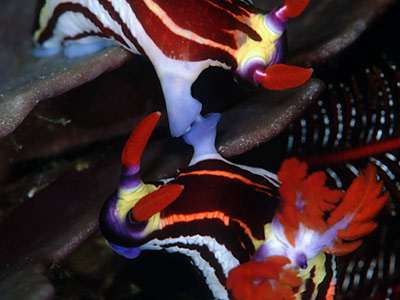
[Note added 4 March 2008: This is the new species Nembrotha aurea - see message #21419]
Dear Bill,
I send these photos because they show the mating ability of this species, even if not side by side on the same level. I find it really amazing!
Locality: Rinja island. Indonesia. Depth: 18 metres. Length: 7 cm. June 2003. healthy reef. Photographer: Roberto Sozzani
Best regards
Roberto Sozzani
www.robertosozzani.it
roberto.sozzani@fastwebnet.it
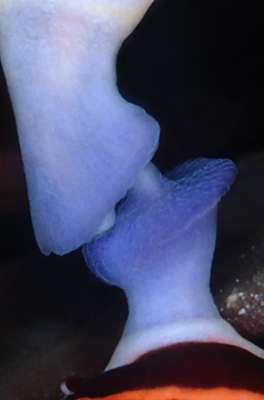
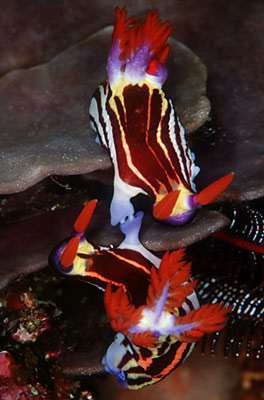
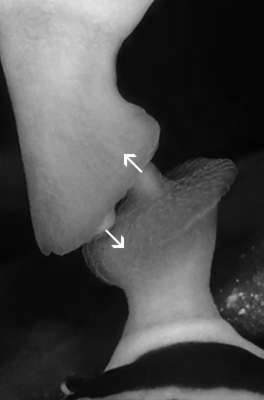
Dear Roberto,
Thanks for these interesting photos. We have a number of mating photos of this species on the Forum but yours shows a rather interesting feature. The large disc-shaped structure which extends out when mating, is not just the penis but is the whole of the genital vestibule or pouch [which usually forms an internal pocket in the body wall]. In your close-up, the actual penis can be seen as a small papilla [my arrows show direction of sperm transfer] which arises from the centre of the flattened disc. The female opening is off to the side of the disc. In many opisthobranchs only the penis extends out like this and the female genital opening is at the base of the penis. So this is quite a different arrangement. What I am not clear about is where the eggs are extruded. It is possible there is a third opening? The eggs are not layed during mating so perhaps the same genital aperture is used but it is hidden within the genital vestibule during egg laying.
Why this is particularly interesting is that most of out knowledge of the functioning reproductive system is derived from dissections of preserved animals. Because various ducts extend and contract in relation to other ducts during mating and egg laying it is often difficult to interpret how parts of the system work.
Best wishes,
Bill Rudman
Nembrotha purpureolineata from Mozambique
February 7, 2005
From: Charles Rowe
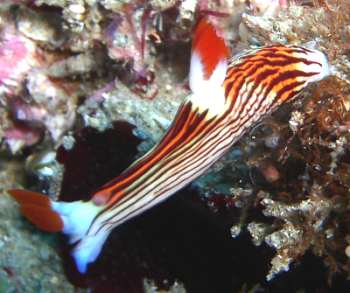
[Note added 4 March 2008: This is the new species Nembrotha aurea - see message #21419]
Hi Bill,
Here is another photo I would like identified.
Locality: Bass City, Ponto Malongame, Mozambique. 26 November 2004. 20 metres.
See ya.
Charles.
billr@seaslugforum.net
Rowe, C., 2005 (Feb 7) Nembrotha purpureolineata from Mozambique. [Message in] Sea Slug Forum. Australian Museum, Sydney. Available from http://www.seaslugforum.net/find/13042Dear Charles,
At the moment this is being identified as Nembrotha purpureolineata.
Best wishes,
Bill Rudman
Nembrotha purpureolineata on an unusual path
August 15, 2003
From: Valda Fraser
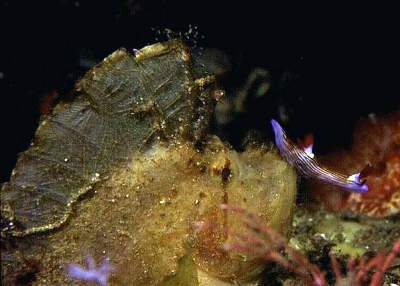
[Note added 4 March 2008: This is the new species Nembrotha aurea - see message #21419]
Dear Bill
I really enjoyed watching this little drama playing itself out. The Nembrotha purpureolineata crawled over the paper fish from tail to "nose". Eventually the fish got mad and sent the nudibranch on its merry with a squirt of water.
Location: Pumula, KwaZulu-Natal, South Africa, 24m
Date: July 2003
Size: 15mm
Regards
Valda Fraser
valdafraser@mweb.co.za
Fraser, V., 2003 (Aug 15) Nembrotha purpureolineata on an unusual path. [Message in] Sea Slug Forum. Australian Museum, Sydney. Available from http://www.seaslugforum.net/find/10730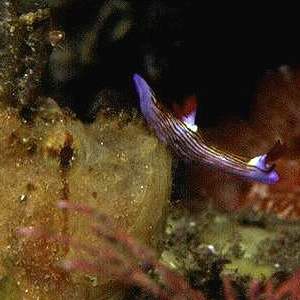
Thanks Valda,
Although I love them, I guess 'pretty but pretty stupid' would be one way to describe most nudibranchs
Cheers,
Bill Rudman
Nembrotha purpureolineata from Indonesia
November 28, 2002
From: Jim Bartlett
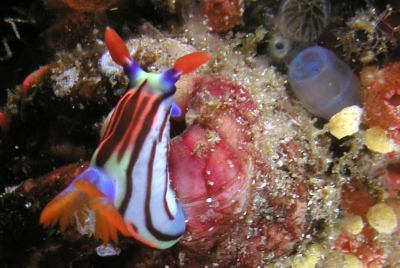
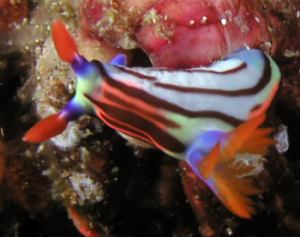
[Note added 4 March 2008: This is the new species Nembrotha aurea - see message #21419]
Bill
Attached is a photo of a second nudibranch I photographed in Indonesia earlier this month (November 2002). Out of the 20-some species I photographed, this is one of two I can't ID. It was shot on a night dive on Pentai Merah off Komodo Island) appears to be a some variety of Nembrotha... similar to the Purple Lined Nembrotha, but I couldn't ID it positively.
Thanks for your help
Jim Bartlett
jim_bartlett@pinnicle.com
Bartlett, J., 2002 (Nov 28) Nembrotha purpureolineata from Indonesia. [Message in] Sea Slug Forum. Australian Museum, Sydney. Available from http://www.seaslugforum.net/find/8503Dear Jim,
This is what we are calling at present Nembrotha purpureolineata. As you will see if you follow some of the earlier messages, there is still some difficulty in clarifying just which are species and which are just colour varieties in this group of similarly coloured species. Your photo shows the animal in 'ascidian alley'. I think it is even sitting on a big one. It will be a while before we know just how choosy each species of Nembrotha is determining which ascidian it will eat and which it will reject. I have added your 'details' to the Participants List.
Best wishes,
Bill Rudman
Nembrotha purpureolineata feeding?
October 25, 2002
From: Scott Johnson
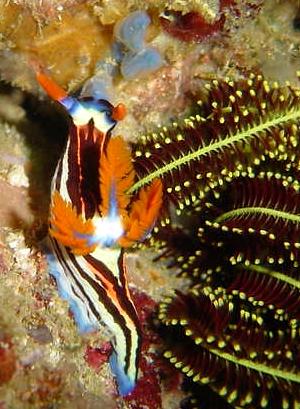
[Note added 4 March 2008: This is the new species Nembrotha aurea - see message #21419]
Hi Bill,
Attached is a photo of either Nembrotha purpureolineata or N. rutilans. The photo was taken by Patrick Zurick at a dive site called Pink Beach/Pantai Merah off the island of Komodo, Indonesia, on August 19 of this year at about 5:20 pm. It appears that the animal might be eating those pale blue tunicates on the substrate just in front of its head.
Scott
johnson@kmr.ll.mit.edu
Johnson, S., 2002 (Oct 25) Nembrotha purpureolineata feeding?. [Message in] Sea Slug Forum. Australian Museum, Sydney. Available from http://www.seaslugforum.net/find/8239Thanks Scott,
You are right to hesitate over the identity of these animals. I will put them with your first choice, Nembrotha purpureolineata, but not with any great conviction. It certainly seems to have more than a passing interest in the blue ascidians, but I can't really see if any of the oral tube is evereted.
Best wishes,
Bill Rudman
Nembrotha purpureolineata from Komodo
August 7, 2002
From: Walabha Sinbul

[Note added 4 March 2008: This is the new species Nembrotha aurea - see message #21419]
Dear Bill,
Long time no see.
Here is a shot of a strikingly beautiful nudibranch for your forum. Can you please help identify my find from Batu Bolong, Komodo island, Indonesia. Is this guy a Nembrotha purpureolineata or something else?
Thank you so much Bill.
Dive site: Batu Bolong, Komodo island
Date: July 26, 02
Depth: approximately 45ft
Activity: feeding on sea squirts
Length: 5cm
Best wishes,
Walabha
walabha@clickta.com
Sinbul, W., 2002 (Aug 7) Nembrotha purpureolineata from Komodo. [Message in] Sea Slug Forum. Australian Museum, Sydney. Available from http://www.seaslugforum.net/find/7699Dear Walabha,
Yes this is what we are calling Nembrotha purpureolineata.
Best wishes,
Bill Rudman
Nembrotha purpureolineata from Japan
May 30, 2002
From: Yasuhiro Shirai
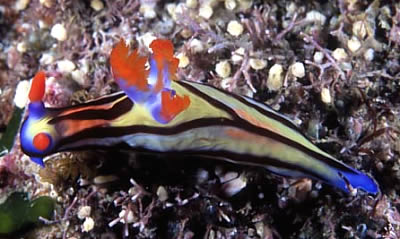
[Note added 4 March 2008: This is the new species Nembrotha aurea - see message #21419]
Dear Bill,
Thank you for your advice on my messages every time. I think the animal in Ken-Ichi Ohno's message is Nembrotha purpureolineata. I have attached a photo Nembrotha purpureolineata which I think is similar to Ohno's animal.
Data:
City Tanabe, Prefecture Mie at Kii peninsula, central Japan.
May 05,2002. 21 Degree,Length: 60mm. Depth: -27m.
Best wishes,
Yasuhiro Shirai
yasuhiro@sea-slug.com
Shirai,Y., 2002 (May 30) Nembrotha purpureolineata from Japan. [Message in] Sea Slug Forum. Australian Museum, Sydney. Available from http://www.seaslugforum.net/find/6950Dear Yasuhiro,
Your photo certainly shows what Ohno's animal will grow into. Our only problem now is sorting out whether Nembrotha purpureolineata and Nembrotha rutilans and the other similarly coloured species ar separate species or colour forms of one species.
Best wishes,
Bill Rudman
Nembrotha purpureolineata? from Sulawesi
May 11, 2002
From: Mary Jane Adams
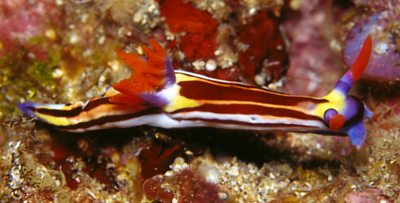
[Note added 4 March 2008: This is the new species Nembrotha aurea - see message #21419]
Hi Bill,
I believe this is Nembrotha purpureolineata. Crawling length was about 5cm. Divesite: Tanjung Tebal, a coral reef with interspersed white sand slope. Lembeh Strait, Sulawesi, Indonesia. April 13, 2002
Best regards,
Mary Jane
divepng@yahoo.com
Adams, M J., 2002 (May 11) Nembrotha purpureolineata? from Sulawesi. [Message in] Sea Slug Forum. Australian Museum, Sydney. Available from http://www.seaslugforum.net/find/6884Thanks Mary Jane,
I think Nembrotha purpureolineata is a reasonable place to put it at present, but I am putting this group with very broad dark bands in with N. rutilans. If you look at the photo of two animals mating it suggests that at least the animals with broad longitudinal bands merge with those with a solid block of dark brown.
Best wishes,
Bill Rudman
Nembrotha? from Japan
May 10, 2002
From: Ken-Ichi Ohno
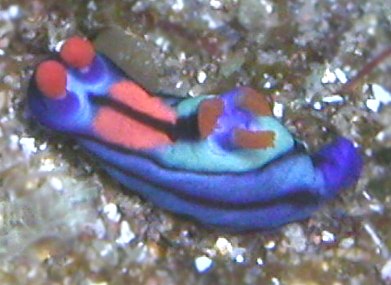
[Note added 4 March 2008: This is the new species Nembrotha aurea - see message #21419]
How do you do,
Here is a photograph of Sea Slug which was taken in Suruga Bay, Japan, near Osezaki in 24m. The size was about 1cm. We thought perhaps it is new as we have not seen it before. I am an assistant medical examiner in Tokyo Met.. Although I dive as a hobby, I am very interested in marine life.
Ken-Ichi Ohno
scuba@vesta.ocn.ne.jp
Ohno, K., 2002 (May 10) Nembrotha? from Japan. [Message in] Sea Slug Forum. Australian Museum, Sydney. Available from http://www.seaslugforum.net/find/6869Dear Ohno,
Thanks for this interesting photo. I am fairly sure that it is a juvenile, and probably a species of Nembrotha. The colour looks unlike any species I am familiar with but as we know very little about colour variation in these animals I can't say whether this is a known species that changes colour as it grows into an adult, or whether it is an unnamed species. Has anyone else seem a colour like this before?
Best wishes,
Bill Rudman
Nembrotha purpureolineata from Westn Australia
April 1, 2001
From: Kirk Gibson
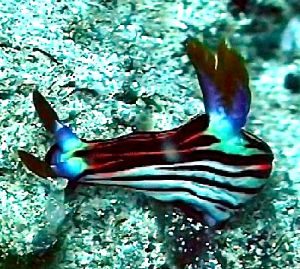
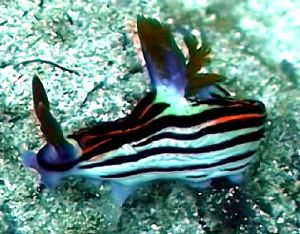
[Note added 4 March 2008: This is the new species Nembrotha aurea - see message #21419]
This is a new nudibranch for me from Exmouth, Western Australia. I found it on a dive today [30 March 2001] at the Murrion Islands.
Kirk Gibson
captainkirk@wn.com.au
Gibson, K., 2001 (Apr 1) Nembrotha purpureolineata from Westn Australia. [Message in] Sea Slug Forum. Australian Museum, Sydney. Available from http://www.seaslugforum.net/find/4095Dear Kirk,
This is a species of Nembrotha, but it belongs to a group which may be one very variable species or a group of similarly coloured species. Have a look at Ken Knezick's photo and my comments.
I am tentatively identifying you animal as Nembrotha purpureolineata, but I am not very convinced.
Best wishes,
Bill Rudman
Nudibranchs of Southern Africa
February 10, 2001
From: Yvonne Rozsenich
[Note added 4 March 2008: This is the new species Nembrotha aurea - see message #21419]
Could you please tell me the name of the nudibranch that is on the cover of Terrence Gosliner's Nudibranchs of Southern Africa, and what it eats.
Thanks,
Yvonne
yrozsenich@earthlink.net
Rozsenich, Y., 2001 (Feb 10) Nudibranchs of Southern Africa. [Message in] Sea Slug Forum. Australian Museum, Sydney. Available from http://www.seaslugforum.net/find/3748Dear Yvonne,
In Terry's book he identifies it as Nembrotha purpureolineata, which is one of a group of similarly coloured species which are still a bit of a puzzle. There may be a number of species, or just one which is very variable in colour.
Species of Nembrotha feed on colonial ascidians. Each species is probably quite choosy, but we don't know enough about these animals to be able to tell you which actual species of ascidian it will eat.
Best wishes,
Bill Rudman
Mating Activity - Nembrotha rutilans
January 18, 2001
From: Ken Knezick
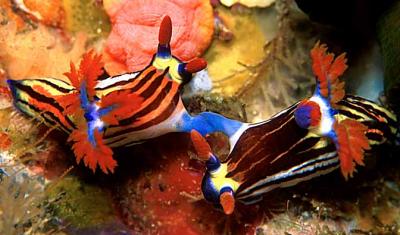
[Note added 4 March 2008: This is the new species Nembrotha aurea - see message #21419]
Thank you for your ID of my Ceratosoma sinuata. I greatly appreciate the knowledge base represented by this list.
Thought you would enjoy the accompanying photo, taken near Padar Island, Indonesia (part of Komodo National Park).
I watched these two individuals find one another and begin mating. After exhausting my film, I surfaced, had lunch, returned two and a half hours later, and they were still colorfully engaged.
Color me jealous!
Cheers,
Ken
ken@islandream.com
Knezick, K., 2001 (Jan 18) Mating Activity - Nembrotha rutilans. [Message in] Sea Slug Forum. Australian Museum, Sydney. Available from http://www.seaslugforum.net/find/3551Dear Ken,
Apart from being a very colourful photo, this shot has some valuable scientific information. There are a number of very similarly coloured 'species' of Nembrotha which have been considered good species by some and perhaps just colour varieties by others. For example compare Nembrotha rutilans with Nembrotha purpureolineata, Nembrotha megalocera, Nembrotha sp. 1 and Nembrotha sp. 2.
In your photo, one of the animals has 5 relatively thin brown lines and the other has 3 broad dark brown bands. I am not sure that this solves everything, but it certainly shows that quite major colour differences can occur in one species.
The Forum is both a place to get things identified and a place to share information and interesting photos. Over the last few years we have gained a lot of interesting information on the biology of these amazing animals, which is of scientific value. So apart from nice photos of interesting animals, if you have photos of animals 'doing things' such as feeding, breeding, laying eggs etc they would be very welcome,
Best wishes,
Bill Rudman
Nembrotha from Philippines
March 14, 2000
From: Erwin Koehler
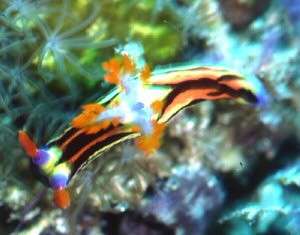
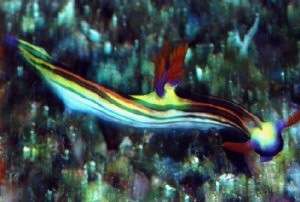
[Note added 4 March 2008: This is the new species Nembrotha aurea - see message #21419]
Dear Bill,
These two photos are by Werner Steinert, made at the Cebu Is, Philippines.
UPPER PHOTO: divesite "Wall of Death I", July 24, 1999, depth 10 m, size unrecorded.
LOWER PHOTO: divesite "Liloan I", July 22, 1999, depth 11 m, size unrecorded.
Erwin
Medslugs.Koehler@t-online.de
Koehler, E., 2000 (Mar 14) Nembrotha from Philippines. [Message in] Sea Slug Forum. Australian Museum, Sydney. Available from http://www.seaslugforum.net/find/2005Dear Erwin,
I think these two are the same species. I also am not sure whether we are dealing with one variable species or a group of similarly coloured species. I think it is less complicated if I call them to be Nembrotha cf. purpureolineata until we get the group sorted out.
Best wishes,
Bill Rudman.
Nembrotha purpureolineata from South Africa
December 20, 1999
From: Valda Fraser
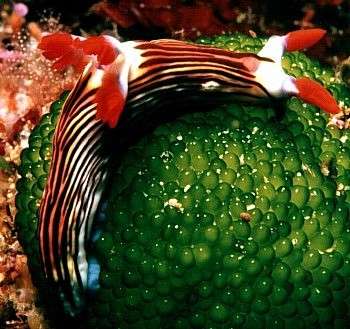
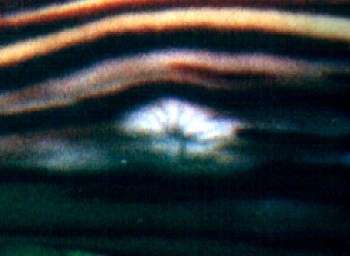
[Note added 4 March 2008: This is the new species Nembrotha aurea - see message #21419]
Dear Bill
Could you tell me what this barnacle-like thing is on the side of this Nembrotha purpureolineata.
Locality: South Coast KwaZulu-Natal SOUTH AFRICA. Scottburgh, 25m. November 1999. Size: 55mm
Regards
Valda Fraser
iti04937@mweb.co.za
Fraser, V., 1999 (Dec 20) Nembrotha purpureolineata from South Africa. [Message in] Sea Slug Forum. Australian Museum, Sydney. Available from http://www.seaslugforum.net/find/1658Dear Valda,
That is the common genital opening which is situated on the right side just behind the head in all nudibranchs. As sea slugs are all hermaphrodites, there are in fact two openings which are only seen by dissection or during mating or egg laying, one for the penis, and one for the vagina. For mating to take place, nudibranchs need to position themselves with their right sides in contact (starboard to starboard - in nautical parlance).
Have a look at the pages on Torsion and Detorsion for some background information on why the reproductive openings ende up on the right side.
Cheers,
Bill Rudman.
